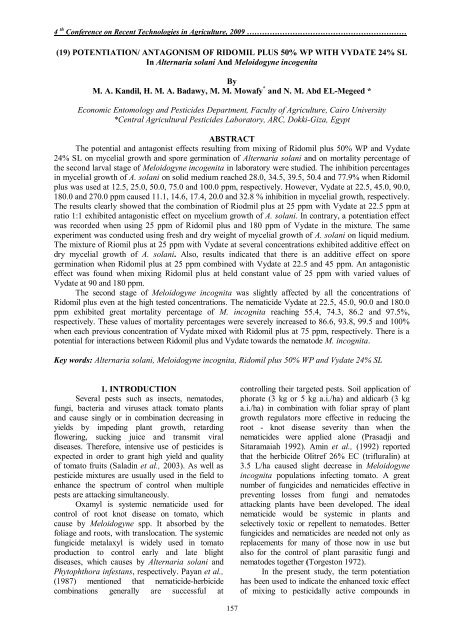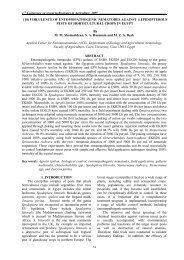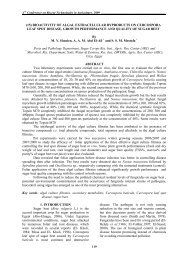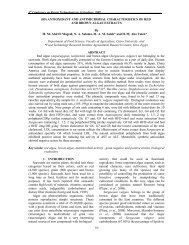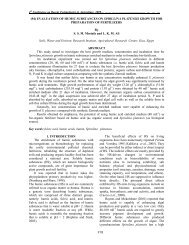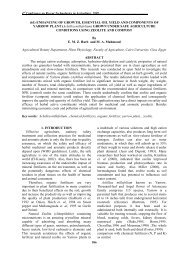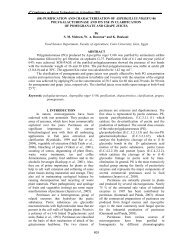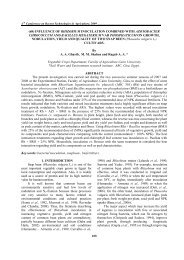1- Pesticides used
1- Pesticides used
1- Pesticides used
Create successful ePaper yourself
Turn your PDF publications into a flip-book with our unique Google optimized e-Paper software.
4 th Conference on Recent Technologies in Agriculture, 2009 ………………………………………………………(19) POTENTIATION/ ANTAGONISM OF RIDOMIL PLUS 50% WP WITH VYDATE 24% SLIn Alternaria solani And Meloidogyne incogenitaByM. A. Kandil, H. M. A. Badawy, M. M. Mowafy * and N. M. Abd EL-Megeed *Economic Entomology and <strong>Pesticides</strong> Department, Faculty of Agriculture, Cairo University*Central Agricultural <strong>Pesticides</strong> Laboratory, ARC, Dokki-Giza, EgyptABSTRACTThe potential and antagonist effects resulting from mixing of Ridomil plus 50% WP and Vydate24% SL on mycelial growth and spore germination of Alternaria solani and on mortality percentage ofthe second larval stage of Meloidogyne incogenita in laboratory were studied. The inhibition percentagesin mycelial growth of A. solani on solid medium reached 28.0, 34.5, 39.5, 50.4 and 77.9% when Ridomilplus was <strong>used</strong> at 12.5, 25.0, 50.0, 75.0 and 100.0 ppm, respectively. However, Vydate at 22.5, 45.0, 90.0,180.0 and 270.0 ppm ca<strong>used</strong> 11.1, 14.6, 17.4, 20.0 and 32.8 % inhibition in mycelial growth, respectively.The results clearly showed that the combination of Riodmil plus at 25 ppm with Vydate at 22.5 ppm atratio 1:1 exhibited antagonistic effect on mycelium growth of A. solani. In contrary, a potentiation effectwas recorded when using 25 ppm of Ridomil plus and 180 ppm of Vydate in the mixture. The sameexperiment was conducted using fresh and dry weight of mycelial growth of A. solani on liquid medium.The mixture of Riomil plus at 25 ppm with Vydate at several concentrations exhibited additive effect ondry mycelial growth of A. solani. Also, results indicated that there is an additive effect on sporegermination when Ridomil plus at 25 ppm combined with Vydate at 22.5 and 45 ppm. An antagonisticeffect was found when mixing Ridomil plus at held constant value of 25 ppm with varied values ofVydate at 90 and 180 ppm.The second stage of Meloidogyne incognita was slightly affected by all the concentrations ofRidomil plus even at the high tested concentrations. The nematicide Vydate at 22.5, 45.0, 90.0 and 180.0ppm exhibited great mortality percentage of M. incognita reaching 55.4, 74.3, 86.2 and 97.5%,respectively. These values of mortality percentages were severely increased to 86.6, 93.8, 99.5 and 100%when each previous concentration of Vydate mixed with Ridomil plus at 75 ppm, respectively. There is apotential for interactions between Ridomil plus and Vydate towards the nematode M. incognita.Key words: Alternaria solani, Meloidogyne incognita, Ridomil plus 50% WP and Vydate 24% SL1. INTRODUCTIONSeveral pests such as insects, nematodes,fungi, bacteria and viruses attack tomato plantsand cause singly or in combination decreasing inyields by impeding plant growth, retardingflowering, sucking juice and transmit viraldiseases. Therefore, intensive use of pesticides isexpected in order to grant high yield and qualityof tomato fruits (Saladin et al., 2003). As well aspesticide mixtures are usually <strong>used</strong> in the field toenhance the spectrum of control when multiplepests are attacking simultaneously.Oxamyl is systemic nematicide <strong>used</strong> forcontrol of root knot disease on tomato, whichcause by Meloidogyne spp. It absorbed by thefoliage and roots, with translocation. The systemicfungicide metalaxyl is widely <strong>used</strong> in tomatoproduction to control early and late blightdiseases, which causes by Alternaria solani andPhytophthora infestans, respectively. Payan et al.,(1987) mentioned that nematicide-herbicidecombinations generally are successful atcontrolling their targeted pests. Soil application ofphorate (3 kg or 5 kg a.i./ha) and aldicarb (3 kga.i./ha) in combination with foliar spray of plantgrowth regulators more effective in reducing theroot - knot disease severity than when thenematicides were applied alone (Prasadji andSitaramaiah 1992). Amin et al., (1992) reportedthat the herbicide Olitref 26% EC (trifluralin) at3.5 L/ha ca<strong>used</strong> slight decrease in Meloidogyneincognita populations infecting tomato. A greatnumber of fungicides and nematicides effective inpreventing losses from fungi and nematodesattacking plants have been developed. The idealnematicide would be systemic in plants andselectively toxic or repellent to nematodes. Betterfungicides and nematicides are needed not only asreplacements for many of those now in use butalso for the control of plant parasitic fungi andnematodes together (Torgeston 1972).In the present study, the term potentiationhas been <strong>used</strong> to indicate the enhanced toxic effectof mixing to pesticidally active compounds in157
Potentiation/ antagonism of Ridomil plus 50% WP with Vydate 24%.........................................................................comparison to synergism where the toxicity of apesticide is increased by the addition of anpesticidally non-toxic compound. When twocompounds are mixed, they can either potentiatingor additive or antagonistic in target pest.The aim of interaction research withpesticides should be directed to determineparticular combinations of pesticides that will giveacceptable pest control at doses lower than thosenormally <strong>used</strong> in single applications (Akobundu etal., 1975). Therefore, the present study aimed toinvestigate interactions between the fungicideRidomil plus 50% WP and the nematicide Vydate24% SL towards growth of the fungus Alternariasolani and the nematode Meloidogyne incognita.2. MATERIAL AND METHODS2. 1. Tested pesticides2. 1. 1. Oxamyl (Vydate 24% SL)N,N-dimethyl-2-methylcarbamoyloxyimino-2-(methylthio) acetamide.Vydate 24% SL was recommended in Egyptagainst root knot disease on tomato at rate 3L/Fed.2. 1. 2. Metalaxyl (Ridomil plus 50%WP)Methyl N- (methoxyacetyl) -N- (2, 6-xylyl)DL-alaninate. Ridomil plus 50% WP containmetalaxyl (15%) + copper oxychloride (35%). Itwas recommended in Egypt against early blightdisease on tomato at rate 150 g/100 L water.2.2. Evaluation methods of pesticides efficiencyagainst A. solaniThe strain of Alternaria solani wasobtained from Plant Pathology Research Institute,Agriculture Research Center (ARC), Giza, whichisolated from infected tomato plants with earlyblight disease and identified according to theircultural and morphological characteristics. Thefungus was maintained on Potato-Dextrose-Agar(PDA) and (PD broth) mediums to serve as asource of inoculation.2.2.1. Mycelial growth in solid mediumA serial of concentrations of <strong>used</strong> pesticideswere prepared. Ridomil plus concentrations wereprepared at 12.5, 25, 50, 75 and 100 ppm, whileVydate was at 22.5, 45, 90, 180 and 270 ppmusing sterilized distilled water. Also, mixture ofRidomil plus 50% WP and Vydate 24% SL wastested for interaction effects toward A. solani. Thetested concentrations of the mixture were preparedby adding 25 ppm only of Ridomil plus to eachprevious concentration of Vydate. Poison FoodTechnique (PFT) of Togeston (1957) was <strong>used</strong> totest both pesticides and their mixture against A.solani. The inhibition of mycelial growth andinteraction effects were calculated as outlinedbelow.2.2.2. Fresh and dry weights of mycelial growthin liquid mediumThe effect of tested pesticides on fresh anddry weight of mycelial growth of A. solani inliquid media (potato dextrose PD) was measured.The previous concentrations of pesticidetreatments were mixed with the sterilized PDmedium after cooling at 45ºC. Each treatment wasreplicated three times. One treatment wasmaintained as control where no pesticide wasadded to the PD medium. After mixing thepesticides, the fungus A. solani was seeded in theliquid medium using 5 mm agar disc having activemycelial growth of the fungus and incubated at25 ± 2 ºC for 7 days. At the end of incubationperiod, colony growth was collected in eachtreatment when the hyphal growth of fungus wascompleted in untreated liquid medium. Theharvested mycelia of A. solani were filtratedthrough filter paper, weighed and then dried at 90ºC for 48h. The inhibition percentage of mycelialgrowth and interaction effects between the bothtested pesticides were calculated as outlinedbelow.2.2.3. Spore germinationThe effect of tested pesticides and theirmixture on spore germination of A. solani wasconducted according to the method of Mills et al.,(2004). A series of increasing concentrations ofRidomil plus 50% WP, Vydate 24% SL and theirmixture were prepared in water. The testedconcentrations of Ridomil plus were 18.75, 37.5,75, 150 and 300 ppm, while were 22.5, 45, 90,180 and 360 ppm for Vydate. The testedconcentrations of the mixture were prepared byadding 25 ppm only of Ridomil plus to eachprevious concentration of Vydate. Sporesgermination was determined by count thegerminated spores; it considered germinating ifthe length of the germ-tube was at least as long asthe width of the spore. The percent inhibition ofspores germination and interaction effects werecalculated as outlined below.2.3. Evaluation the efficiency of pesticidesagainst Meloidogyne incognitaThe effect of tested pesticides and theirmixture on the second larval stage of M. incognitawas assayed according to the method described byFeldmesser (1972). Egg-masses of root-knotnematode, M. incognita were directly collectedfrom infested roots of tomato plants in greenhouseof Central Agricultural <strong>Pesticides</strong> Laboratory andthen placed in clean flask containing distilledwater. Newly hatched second stages (juveniles)were grouped into portions of about one hundredjuveniles for use in each replicate. Threereplicates were <strong>used</strong> for each treatment. Ridomil158
4 th Conference on Recent Technologies in Agriculture, 2009 ………………………………………………………plus concentrations were prepared at 18.75, 37.5,75, 150 and 300 ppm, while Vydate solutionsconsisted of 22.5, 45, 90, 180 and 360 ppm usingdistilled water. Also, mixture of Ridomil plus50% WP and Vydate 24% SL was tested forinteraction effects toward M. incognita. The testedconcentrations of the mixture were prepared byadding 75 ppm only of Ridomil plus to eachprevious concentration of Vydate. The controltreatment was done using distilled water only. Thefinal volume of each pesticide solution wasprepared in 5 ml in clean glass vials (10 mlvolume). After exposure the juveniles to testedconcentrations for 24 h., the larval mortality wasrecorded and corrected using Abbot’s formula(1925). Mortality percentage and interactioneffects of tested pesticides were calculated asoutlined below.All obtained data from the previousexperiments were subjected to statistical analysisby the method of Busvine (1957) for calculate theregression equation, slope of regression lines,EC 50 and EC 90 of the tested pesticides. Thetoxicity index of each pesticide was determinedaccording to Sun (1950). The Joint action oftested compounds was expressed to the Cotoxicityfactor (CF), estimated according to theequation given by Mansour et al. (1966):Observed inhibition % - Expected inhibition %Co-toxicity factor = X 100Expected inhibition%The Co-toxicity factor was <strong>used</strong> todifferentiate the results into three categories. Apositive factor of 20 or more is consideredpotentiation, a negative of 20 or more isconsidered antagonism and intermediate valuesbetween -20 and +20 indicated additive effect.3. RESULTS AND DISCUSSION3.1. Efficiency of Ridomil plus, Vydate andtheir mixture against A. solani3.1.1. Mycelium growth on solid mediumData presented in Table (1) show the potencyof Ridomil plus 50% WP, Vydate 24% SL andtheir mixture against mycelium growth of A.solani on solid medium. The inhibitionpercentages in mycelial growth of A. solanireached 28.0, 34.5, 39.5, 50.4 and 77.9% whenRidomil plus was <strong>used</strong> at 12.5, 25.0, 50.0, 75.0and 100.0 ppm, respectively. However, thehighest concentration of Vydate (270 ppm)exhibited only 32.8 % inhibition of mycelialgrowth. On the other hand, when Ridomil pluswas <strong>used</strong> at 25 ppm in combination with Vydateat 22.5, 45.0, 90.0 and 180.0 ppm, the inhibitionpercentages reached 29.8, 50.2, 60.4 and 86.3%,respectively. This means that when Ridomil plusmixed with different levels of Vydate the percentinhibition of mycelial growth increasedproportionally with the concentration. In the sametime it is clear that the mixture of both chemicalsenhanced the efficacy than when each chemicaltested alone. This trend was observed when thedata subjected to calculatethye co-toxicity factoras shown in Table (2).Table (2) presented the effect of jointaction between Ridomil plus with Vydate onmycelial growth of A. solani on solid medium.The results clearly showed that the combination ofRiomil plus at 25 ppm with Vydate at 180 ppm(1:1) exhibited a potentiation effect on A. solaniwhich gave 86.3% observed inhibition instead ofexpected inhibition 54.5% in mycelial growthwith a co-toxicity factor + 58.35. An antagonisticeffect was recorded when using the mixture ofRidomil plus at 25 ppm with Vydate at 22.5 ppmat the ratio of 1:1, which gave 29.8% observedinhibition instead of expected inhibition 45.6% inmycelial growth with co-toxicity - 34.65. Themixtures between Ridomil plus at 25 ppm withVydate at 45 and 90 ppm at ratio (1:1), gave 50.2and 60.4% observed inhibition instead of expectedinhibition 49.1 and 51.9% in mycelial growth withco-toxicity factor + 2.24 and + 16.38,respectively, exhibited an additive effect.Accordingly, the co-toxicity factor was increasedwhen the concentration of Vydate in the mixturewas increased indicating that the potentiationaction ca<strong>used</strong> with the increase of Vydateconcentration.3.1.2. Mycelium growth in liquid mediumData in Table (1) showed the inhibitionpercentages in fresh weight of mycelial growth ofA. solani using Ridomil plus 50% WP at 12.5,25.0, 50.0, 75.0 and 100.0 ppm were 26.5, 30.9,33.3, 40.5 and 57.1%, respectively. Thecorresponding values of Vydate 24% SL at 22.5,45.0, 90.0, 180.0 and 270.0 ppm were 16.7, 21.4,26.2, 35.7 and 42.9%, respectively. In case usingRidomil plus at 25 ppm in combination withVydate at 22.5, 45.0, 90.0 and 180 ppm, theinhibition percentages in fresh weight of mycelialgrowth reached 72.3, 85.0, 86.9 and 92.7%,respectively.The same experiment was conductedusing dry weight of mycelial growth of A. solani.The inhibition percentages were 16.5, 42.1, 68.1,72.3 and 81.7 % when Ridomil plus <strong>used</strong> at 12.5,25.0, 50.0, 75.0 and 100.0 ppm, respectively.Vydate at 22.5, 45.0, 90.0, 180.0 and 270.0 ppmca<strong>used</strong> 8.3, 10.4, 16.5, 47.7 and 75.4% inhibitionin dry mycelial growth, respectively. On the otherhand, when Ridomil plus was <strong>used</strong> at 25 ppm in159
Potentiation/ antagonism of Ridomil plus 50% WP with Vydate 24%.........................................................................combination with Vydate at 22.5, 45.0, 90.0 and180 ppm, the observed inhibition percentagesreached 42.9, 54.8, 64.3 and 85.7%, respectively.The results in Table (3) clearly showed thatthe combination of Riomil plus at 25 ppm withVydate at several concentrations exhibited anadditive effect on A. solani mycelium. Themixtures between Ridomil plus at 25 ppm withVydate at 22.5, 45.0, 90.0 and 180.0 ppm at ratio(1:1) gave 42.9, 54.8, 64.3 and 85.7% observedinhibition instead of expected inhibition 50.4,52.5, 58.6 and 89.8% in dry mycelial growth withco-toxicity factors - 14.88, + 4.38, + 9.73 and –4.57, respectively, exhibited an additive effect.Accordingly, there are no relation between theincreasing of Vydate concentration in the mixturewith Ridomil plus and their efficacy against drymycelial growth of A. solani in liquid medium.Most investigations aimed to study theeffect of fungicides alone on the mycelial growthof A. solani (Al-Malla, 1998; Brammall, 1993;Datar and Mayee, 1985; Jovancev, 1998). On theother hand, there are a few available reviewsabout the effect of mixing different types ofpesticides, i.e. insecticides, fungicides, acaricidesand nematicides on fungi growth especially A.solani. Csinos et al., (1986) studied mixing ofmetalaxyl and fenamiphos through irrigationwater to control black shank and root knotcomplex on tobacco fields. The results indicatedthat black shank and root knot complex was bestmanaged where both chemicals were appliedtogether. Hill and Stratton (1991) reported that thefungicide chlorothalonil and herbicide metribuzininteracted in an additive manner at concentrationsup to 900 ppm and antagonistically at levelsgreater than 900 ppm toward A. solani. Atia(1996) found that mixing fungicides Karathane,Rubigan, Afugan or Bayleton with the insecticideActellic, increased their efficacy against powderymildew of cucumber except Byleton. Shaaban(1993) reported that fungicides Antracol, Ridomil-Mancozeb, Sharis and Dithane M-45 wereconsidered as only additive effect when mixedwith the tested insecticides, except in case ofAntracol/Sumicidin, S.haris/Curacron, DithaneM45 /Curacron and Dithane M45/Larvin gaveantagonistic effect.3.1.3. Spore germinationThe potency of Ridomil plus 50% WP orVydate 24% SL and their mixture against sporegermination of A. solani was tabulated in Table(1). In vitro experiment indicated that theinhibition percentages in spore germination of A.solani reached 45.5, 51.7, 76.5, 85.8 and 89.9%when Ridomil plus was <strong>used</strong> at 12.5, 25.0, 50.0,75.0 and 100.0 ppm, respectively. Thecorresponding values using Vydate at 22.5, 45.0,90.0, 180.0 and 270.0 ppm were 32.1, 43.8, 72.1,78.6 and 82.1 %, respectively. The inhibitionpercentages reached 68.3, 83.5, 90.4 and 93.5%when Ridomil plus held constant at 25 ppm incombination with Vydate at 22.5, 45.0, 90.0 and180 ppm, respectively.The results in Table (4) showed thecomparative inhibition of Ridomil plus andVydate to spore germination of A. solani after 48hours of inoculation. The data indicated thatRidomil plus as expected was more effective thanthe nematicide Vydate against A. solani spores.The EC 50 and EC 90 of Ridomil plus were 17.4 and109.2 ppm, while for Vydate were 48.3 and 407.5ppm. The toxicity indices of the tested pesticidesrevealed that Vydate was 36.0% as toxic asRidomil plus. Meanwhile, even Vydate is anematicide but results showed that it may beexhibited fungicidal effect.Data in Table (5) clearly showed that thereis an additive effect when Ridomil plus at 25 ppmcombined with Vydate at 22.5 and 45 ppm, whichgave 68.3 and 83.5% observed inhibition insteadof the expected inhibition 83.8 and 95.5% in sporegermination of A. solani with co-toxicity factors -18.49 and -12.56, respectively. Additionally,antagonistic effect was recorded when mixingRidomil plus at held constant at 25 ppm withvaried values of Vydate at 90 and 180 ppm, withco-toxicity factors reaching – 26.97 and -28.24,respectively.The present data clearly showed that thecombination of Riomil plus at 25 ppm withVydate at 180 ppm exhibited a potentiation effecton mycelium growth of A. solani (Table 2). Theseresults are in general agreement with dataobtained by Haggag-Karima and Farghly-sayeda(2007) who suggested that the mixture of Ridomilplus and Reldan gave the highest diseasemanagement and may play an important role inminimizing the uses of pesticides. Therefore, it isimportant to develop management strategies toreduce fungicide use, especially on vegetativecrops (Batista et al., 2006).In contrary, mixing of Riomil plus at 25ppm with Vydate at 22.5 and 45 ppm gaveadditive effect, while with 90 and 180 ppm ofVaydate ca<strong>used</strong> antagonistic effect on spore'sgermination. This finding may be due to chemicalor biological incompatibility. Generally, theseresults are agreement with El-Safty et al. (2000)160
4 th Conference on Recent Technologies in Agriculture, 2009 ………………………………………………………Table (1): Effect of different concentrations of Ridomil plus 50% WP or Vydate 24% SL andtheir mixture on mycelial growth (solid and liquid medium) and sporegermination of A. solani under laboratory conditions.TreatmentsRidomil plus50% WPVydate 24% SL25 ppm ofRidomil plus +VydateConcentration(ppm)Inhibition percentage in mycelium growthonLiquid mediumSolidmedium Fresh weight Dry weightInhibition (%)of sporegermination12.5 28.0 26.5 16.5 45.525 34.5 30.9 42.1 51.750 39.5 33.3 68.1 76.575 50.4 40.5 72.3 85.8100 77.9 57.1 81.7 89.922.5 11.1 16.7 8.3 32.145 14.6 21.4 10.4 43.890 17.4 26.2 16.5 72.1180 20.0 35.7 47.7 78.6270 32.8 42.9 75.4 82.122.5 29.8 72.3 42.9 68.345 50.2 85.0 54.8 83.590 60.4 86.9 64.3 90.4180 86.3 92.7 85.7 93.5Table (2): Toxicity of Ridomil plus 50% WP and Vydate 24% SL mixture when Ridomil plus held constantat 25 ppm with several concentrations of Vydate 24% SL to mycelial growth of A. solani on solidmedium after seven days of inoculation.Combinationsinhibition (%) in myceliumgrowth of A. solaniRidomil plus (ppm) + Vydate (ppm) Observed ExpectedCo-toxicityfactorJoint actioncategory25 + 22.5 29.8 45.6 - 34.65 Antagonist25 + 45.0 50.2 49.1 + 2.24 Additive25 + 90.0 60.4 51.9 + 16.38 Additive25 + 180.0 86.3 54.5 + 58.35 PotentiationTable (3): Toxicity of Ridomil plus 50% WP and Vydate 24% SL mixture when Ridomil plus heldconstant at 25 ppm with several concentrations of Vydate 24% SL to dry mycelial growth of A.solani in liquid medium after seven days of inoculation.Combinationsinhibition (%) in myceliumgrowth of A. solaniRidomil plus (ppm) + Vydate (ppm) Observed ExpectedCo-toxicityfactorJoint actioncategory25 + 22.5 42.9 50.4 - 14.88 Additive25 + 45.0 54.8 52.5 + 4.38 Additive25 + 90.0 64.3 58.6 + 9.73 Additive25 + 180.0 85.7 89.8 - 4.57 Additive161
Potentiation/ antagonism of Ridomil plus 50% WP with Vydate 24%.........................................................................Table (4): Comparative inhibition of Ridomil plus 50% WP and Vydate 24% SL to sporegermination of A. solani after 48 hours of inoculation.EC level of tested pesticidesToxicityTreatments(ppm)SlopeindexEC 50 EC 90Ridomil plus 50% WP 17.4 109.2 1.60 ±0.19 100.0Vydate 24% SL 48.3 407.5 1.38 ± 0.15 36.0Table (5): Toxicity of Ridomil plus 50% WP and Vydate 24% SL mixture when Ridomil plus held constant at 25ppm with several concentrations of Vydate 24% SL to spores germination of A. solani after 48 hours ofinoculation.Combinationsinhibition (%) in myceliumgrowth of A. solaniRidomil plus (ppm) + Vydate (ppm) Observed ExpectedCo-toxicityfactorJoint actioncategory25 + 22.5 68.3 83.8 -18.49 additive25 + 45.0 83.5 95.5 -12.56 additive25 + 90.0 90.4 >100.0 -26.97 antagonist25 + 180.0 93.5 >100.0 -28.24 antagonistTable (6): Effect of different concentrations of Ridomil plus 50% WP, Vydate 24% SL and theirmixture on second stage of M. incognita.TreatmentsConcentration(ppm)Mortality (%) in 2 nd stage of M.incognitaRidomil plusVydateRidomil plus at 75 ppm) +Vydate25.0 1.850.0 2.475.0 3.8150.0 7.9300.0 13.822.5 55.445.0 74.390.0 86.2180.0 97.522.5 86.645.0 93.890.0 99.5180.0 100.0Table (7): Toxicity of Ridomil plus 50% WP and Vydate 24% SL mixture when Ridomil plus held constant at 75ppm with several concentrations of Vydate 24% SL to second stage of M. incognita.CombinationsMortality (%) in 2 nd stage ofM. incognitaCo-toxicityfactorJoint actioncategoryRidomil plus (ppm) + Vydate (ppm) Observed Expected75 + 22.5 86.6 59.2 + 46.28 potentiation75 + 45.0 93.8 78.1 + 20.10 potentiation75 + 90.0 99.5 90.0 + 10.56 additive75 + 180.0 100.0 >100.0 - 1.28 additive162
4 th Conference on Recent Technologies in Agriculture, 2009 ………………………………………………………who studied the effect of mixing fungicides;Dithane M 45, S- haris and Ridomil-Mancozebwith different insecticides on spores germinationof A. solani. The results indicated that the highconcentrations of the three above fungicides,which were very effective against the fungus, theirmixtures with insecticides did not give any changein efficacy. The same results were obtained fromthe studies of fungicides/insecticides combinationby Ibraham et al. (1976), Shaaban (1993) and Atia(1996).3.2. Efficiency of Vydate or Ridomil plus andtheir mixture against Meloidogyne incognitaThe results recorded in Table (6) show theeffect of both pesticides and their mixture on thesecond stage of M. incognita. Data indicated thatthe second stage of M. incognita was slightlyaffected by all the concentrations of Ridomil pluseven at the high tested concentrations. Thenematicide Vydate exhibited great mortalitypercentage of M. incognita after 24 hours ofapplication, which reaching 55.4, 74.3, 86.2 and97.5% at concentrations of 22.5, 45.0, 90.0 and180.0 ppm, respectively. The observed mortalitypercentages were severely increased to 86.6, 93.8,99.5 and 100% when each previous concentrationof Vydate mixed with Ridomil plus at 75 ppm,respectively.Table (7) presented the joint action betweenRidomil plus and Vydate on the second stage ofM. incognita. The results clearly showed that thecombination of Ridomil plus at 75 ppm withVydate at 90.0 and 180 ppm (at the ratio 1:1)exhibited an additive effect on M. incognita,which their observed mortality percentagesreaching 99.5 and 100 % instead of the expectedmortality percentages 90.0 and 101.3% with cotoxicityfactors + 10.56 and - 1.28, respectively.There is potentiation effect was recorded using themixture between Ridomil plus at 75 ppm andVydate at 22.5 and 45 ppm, which gave 86.6 and93.8% observed mortality percentages instead ofexpected mortality percentages 59.2 and 78.1%with co-toxicity factors + 46.28 and + 20.10,respectively. This indicates that there is a potentialfor interactions between Ridomil plus and Vydatetowards the nematode M. incognita. One the otherhand, it was found that the low concentrations ofVaydate (22.5 and 45 ppm) in the mixturewith Ridomil plus gave potentiation effect, whiletheir high concentrations (90 and 180 ppm)ca<strong>used</strong> additive effect. Accordingly, there is anegative relationship between increasing theconcentrations of Vaydate in the mixture withRidomil plus at 75 ppm and their efficacy againstthe second stage of M. incognita.The efficacy of different nematicides onhatching and second stage larvae of Meloidogynespp. had been studied by several investigators(Mcloed and Khair 1975; El-Shoura 1981; Payanet al., 1987; Zawam-Hanaa, 1994; Deabes, 1996and Lamberti et al., 2002). On the other hand,there are limit litterateurs about the effect of thecombination of different pesticide types onMeloidogyne spp. The combination betweendifferent pesticides was conducted by Bastian etal. (1984) who found that the nematicidefenamiphos (0.1 ug/ml) alone and in combinationwith the herbicide alachlor (0.1 ug/ml) suppressedthe hatch for 21 days and juvenile survival formore than 21 days. Amin et al. (1992) foundslight decrease in nematode populations in thetreatment of the herbicide trifluralin with sulphur.Anil and Siyanand (1992) found that larvalmortality in the insecticide triazophos treatmentwas maximum followed by FMC 54800 andfenvalerate, respectively. Khalil et al. (1993)reported that the fungicides (Benlate, Sumisclex,Vitox and Daconil) treatments inhibited egghatching, while they had little effect on larvae ofM. incognita. In addition, it was found that Vitoxand Nemacur combination significantly increasedthe percent of mortality as compared withindividual use of Vitox or Nemacur. El-Morshedyet al. (1993) found that cyanophos and methomylproduced moderate toxicity to second larval stageof M. incognita compared with the nematicidesfenamiphos and oxamyl. Abu El-Amayem et al.(2004) found that the mixture of insecticides viz.(dimethoate, primiphose methyl and triazophos)and a standard nematicide (oxamyl) ca<strong>used</strong>significantly reduction in the numbers of rootgalls and second stage juveniles of Meloidogyneincognita in the soil planted with tomato. Theseresults are in general agreement with dataobtained in the present study.Results of the present study indicated thatRidomil plus and Vydate can be mixed togetherand applied to control more than one pest in oneapplication especially the previous research byKandil et al., (2008) found that tank mixture ofboth chemicals was compatible, which theirphysical and chemical properties were withinnormal values. The data presented here emphasizethe need for more research on the ecotoxicinteraction that occurs in mixture of pesticides.<strong>Pesticides</strong> can interact synergistically and /orantagonistically towards both non-targetmicroorganisms and target pests. In either case,these interactions can alter the effects of theindividual pesticides in the mixtures, therebycausing unpredicted responses from testorganisms. In order to accurately predict the163
Potentiation/ antagonism of Ridomil plus 50% WP with Vydate 24%.........................................................................environmental impact of pesticides, it is essentialthat interactions be studied in more detail.4. REFERENCESAbbott W. S. (1925). Amethod of computing theeffectivness of an insecticide. J. Econ.Entomol., 18:265-267.Abu El-Amayem M. M., Radwan M. A., KassemS. M. I. and El-Maadawy E. K. (2004).Root dip technique for evaluating somepesticides against Meliodogyne incognetainfecting tomato. Alexandria journal ofAgricultural Research, 49(1):91-97.Akobundu I. O., Sweet R. D. and Duke W. B.(1975). Amethod of evaluating herbicidecombinations and determine synergism.Weed Sci., 23: 20-25.Al-Malla R. A. (1998). Studied on Tomato EarlyBlight Ca<strong>used</strong> by Alternaria solani (ELL& MARt) Sor. in Egypt. M. Sc. ThesisFac. Agric., Kafr EL-Sheikh, Tanta Univ.,Egypt.Amin W. A., Fatma A. M. and Budai C. S.(1992). Effect of trifluralin and certainpesticides for management ofMeloidogyne incognita on tomato. IndianJ. Nematol., 22(2):89-92.Anil S. and Siyanand (1992). Effect offenvalerate, triazophos and FMC 54800on hatching and mortality of Meloidogyneincognita. Indian J. Nematol., 22(2):134-138.Atia Hanaa A. E. (1996). Effect ofAgrochemicals on the Efficacy ofFungicides for the Control of PowderyMildew on Cucumber. M. Sc. Thesis, Fac.of Agric., Cairo Univ.Bastian A. L., Schmitt D. P. and Barker K. R.(1984). In vitro hatch and survival ofHeterodera glycines as affected byalachlor and phenamiphos. J. Nematol.,16(1):22-26.Batista D. C., Lma M. A., Haddad F., Maffia L.A. and Mizubuti E. S. G. (2006).Validation of decision support systems fortomato early blight and potato late blight,under Brazilian conditions. CropProtection, 25: 664-670.Brammall R. A. (1993). Effect of foliar fungicidetreatment on early blight and yield offresh market tomato on Ontario. PlantDisease, 77(5). 484-488.Busvine J. R. (1957). A critical review of thetechnique for testing insecticides.Commonwealth Inst. Entomol., London.Csinos A.S., Johnson, A.W. and Golden , A.M.(1986). Metalaxyl and fenamiphosapplied through irrigation water to controlblack shank /root knot complex ontomato. Plant Disease 70: 210-213.Datar V. V. and Mayee, C. D. (1985).Management of early blight of tomato. J.Maharashtra Agric. Univ., 5(3): 278-280.Deabes A. A. A. (1996). Effect of GammaIrradiation on Soil Nemtodes Associatedwith Certain Vegetable Crops. M. Sc.Thesis, Fac. Agric., Al-Azhar Univ. 104pp.El-Morshedy M. M. F., Mahrous M. E., Guirguis,M. W. and El-Kady A. M. A. (1993).Toxicity of certain pesticides to eggmassesand second stage larvae ofMeliodogyne javanica under laboratoryconditions. Egypt J. Agric. Res.,71(2):437-444.El-Safty N. A., Morsy N. M. and Ghallab F. M.(2000). The influence of certaininsecticides on the efficacy of somefungicides against blak rot disease oncotton. Egyptian Journal of AgriculturalResearch, 78(3): 1015-1023.El-Shoura M. Y. (1981). Effect of Volatile andNon- Volatile <strong>Pesticides</strong> on the EconomicPests "Efficacy and Persistence of CertainNematicides". Ph.D. Thesis, Fac. Agric.,Alex. Univ., pp139.Feldmesser J. (1972). Comparative laboratory andgreen house evaluation of severalnematicides (Abstr.). J. Nematology,1(1):7-8.Haggag Karima H. E. and Farghly Sayeda F.(2007). Effect of Metalaxyl andChlorpyrifos-Methyl Against Early Blight(Alternaria solani, Sor.) and Whitefly(Bemisia tabaci, Genn.) In Tomato andEggplant. Journal of Applied SciencesResearch, 3(8): 723-732.Hill T.L. and Stratton G.W. (1991).Interactiveeffects of the fungicide chlorothalonil andthe herbicide metribuzin towards thefungal pathogen Alternaria solani. Bull.Environ. Contam. Toxicol. 47: 97-103.Ibraham E. V., Shanmugham N.; Nataragan S. andRamakrishnan G. (1976). An integratedprogramme for controlling pests anddiseases of sesamum. Madras Agric. J.,63: 532-536. (c.f. Rev. Appl. Entomol.,66: 5162.Jovancev P. (1998). Efficacy of some fungicidesfor controlling late blight (Phytophothorainfestance Mont de Barry) and earlyblight (Alternaria solani Sorauer) oftomato. Macedonian Agric. Rev., 45(1-2):45-51.164
4 th Conference on Recent Technologies in Agriculture, 2009 ………………………………………………………Kandil M. A., Badawy H. M. A., Mowafy M. M.and Nasra M. A. El-Megeed (2008). Theinfluence of Ridomil Plus 50% Wp andVydate 24%Sl alone or in combination onsome biochemical constituents of tomatoleaves under the field condition. Egypt J.Agric Res., 86(4):1413-1431.Khalil M. A., El-Morshedy M. M. F., HashemM. H. and El-Zawahri, Aida M. (1993).Efficiency of certain pesticides on soilbornplant pathogenic fungi and root-knotnematode. Assiut J. Agric. Sci. (In Press).Lamberti F., D'Addabbo T., Greco P. and CarellaA. (2002). Efficacy of the liquidformulation of some nematicides. MededRijksuniv Gent Fak Landbouwkd ToegepBiol Wet., 67(3):699-702.Masour N. A., Eldefrawi M. E., Toppazada A.and Zied M. (1966). Toxicological studieson the Egyptian cotton leafwormProdenia litura F. VII, Potentiation andantagonism of organophosphorus andcarbamates. J. Econ. Entomol., 59: 307-311.McLeod R. W. and Khair G. T. (1975). Effect ofoxime carbamate, organophosphoate andbenzimidazole nematicides on life cyclestage of root knot nematodesMeloidogyne spp.. Ann. Appl. Biol., 79:329-341.Mills A. A. S., Platt W. and Hurta R. A. R.(2004). Effect of salt comunds onmycelial growth sporulation and sporegermination of various potato pathogens.Ostharvest Biology and Technology, 34:341-350.Payan L. A., Johnson A. W. and Litterell R. H.(1987). Effects of nematicides andherbicides alone or in combined onMeliodogyne incogneta egg hatch anddevelopment. Annals of AppliedNematology, 1: 67-70.Prasadji J. K. and Sitaramaiah K. (1992). Effect ofplant growth regulators alone and incombination with nematicities on rootknotseverity and meld in tomato. IndianJ. Nematolo., 22(2): 77-81.Saladin G.; Magne C., and Clement C. (2003).Effect of fludioxonil and pyrimethaniltwo fungicides <strong>used</strong> against Botrytiscinerea, on carbohydrate physiology inVitis vinifera L.. Pest ManagementScience, 59 (10): 1083-1092.Shaaban M. N. (1993). Effect of insecticidesfungicidescombination of the biologicalactivity of insecticides. Egypt. J. Appl.Sci., 8(6): 659:666.Sun Y. P. (1950). Toxicity Index-an ImprovedMethod of Comparing theRelativeToxicity of Insecticides. J. Appl.Entmol., 43.45.Torgeston D. C. (1957). Fungicides. Vol. 1,Agriculturral and Industrial alicationsenvironmental interactions. AcademicPress New York and London.Torgeston D.C. (1972). Fungicides andNematicides: Their Role Now and in theFuture. Published in J. Environ Qual 1:14Zawam Hanaa S. (1994). Toxicological Studiesof Some <strong>Pesticides</strong> on Root KnotNematode Meliodogyne spp. M.Sc.Thesis, Fac. Agric., Cairo Univ., 124 pp.Alternaria solaniSL %٢٤ WP %٥٠Meloidogyne incogenitaزيادة فاعلية أو تضاد مبيد الريدوميل بلسمع الفايديتعلىو-محمد عبد الهادي قنديل -هانئ محمود عاشور بدويمحمد مأمون موافي*-نصرة محمد عبد المجيد*جامعة القاهرةكلية الزراعة قسم الحشرات الاقتصادية والمبيدات الدقيمركز البحوث الزراعية *المعمل المركزي للمبيدات مصرالجيزة –––-–على نموو الفايديت ملخصدرس تأثيرات زيادة الفاعلية والتضاد الناتجة من خلط الريدوميل بلسوعلى النسبة المئوية لموت العمر اليرقي الثاني لالميسليوم وإنبات الجراثيم للفطرعلى البيئة الصلبة إلىتصل نسبة التثبيط في نمو ميسليوم فطر جزء في المليون.و عند استخدام الريدوميل بلس بتركيزاتو وجزء في المليون أدت إلىو بينما عند تركيزات الفايديتSL %٢٤WP %٥٠٣٤,٥ ، ٢٨A. solani١٠٠ ٧٥ ، ٥٠ ، ٢٥ ، ١٢,٥٢٠ ، ١٧,٤ ، ١٤,٦ ، ١١,١٢٧٠Alternaria solani.Meloidogyne incogenita% ٧٧,٩ ٥٠,٤ ، ٣٩,٥ ،١٨٠ ، ٩٠ ، ٤٥ ، ٢٢,٥165
Potentiation/ antagonism of Ridomil plus 50% WP with Vydate 24%.........................................................................٢٥.A. solani٢٢,٥% ٣٢,٨تثبيط في نمو الميسليوم على الترتيب. أوضحت النتائج أن خلط الريدوميل بلس عند تركيز جزء في المليونمع الفايديت عند تركيز جزء في المليون بمعدل أعطيا تضاد على نمو ميسليوم فطر على العكس، وجد تأثير زيادة الفاعلية على نمو الميسليوم عند خلط الريدوميل بلس بتركيز جز ء في ال ملي ون م ع الفاي دي ت عن دتركيز جزء في المليون. أجريت نفس التجارب السابقة لدراسة تأثير خلط مبيدي ريدوميل بلس والفايديت على الوزنالرطب والجاف لميسليوم الفطر النامي على بيئة سائله. خلط مبيد الريدوميل بلس عند تركيز جزء في المليون معتر كيزا ت ع دي دة ل مبي د الفاي دي ت أعطى تأثير إضاف ة على ال وزن الجاف ل مي سلي و م الفطر. أوضحت النتائج أيضا ً أن هناك تأثيرإضافة في إنبات جراثيم الفطر عند استخدام الريدوميل بلس بتركيز جزء في المليون مع الفايديت عند تركيزي وجزء في المليون. وجد تأثير مضاد على إنبات الجراثيم عند خلط الريدوميل بلس عند تركيز ثابت جزء في المليونمع تركيزي و جزء في المليون من الفايديت.يتأثر العمر اليرقي الثاني ل تأثيرا ً بسيطا ً عند استخدام جميع تركيزات الريدوميل بلس حتىو ١٨٠جزء في المليون لحدوثالتركيزات العالية. أدي استخدام المبيد النيماتودي فايديت عند تركيزاتو على الترتيب. ت ازداد ب ش ده ن س ب ال م و تم و ت كبير ليرقا ت ال ع مر الثاني وصل إلىالسابقة عند استخدام مبيد الريدوميل بلس عند تركيز جزء في المليون مع التركيزات السابقة لمبيد الفايديت وصلت إلىو على الترتيب. وجد زيادة فاعلية نتيجة تداخل مبيدي الريدوميل بلس والفايديت ضدنيماتودا٢٢,٥٢٥٢٥٢٥٩٠ ، ٤٥ ، ٢٢,٥% ٩٧,٥٢٥١:١M. incogenita٨٦,٢ ، ٧٤,٣ ، ٥٥,٤٧٥١٨٠٩٠١٨٠٤٥% ١٠٠ ٩٩,٥ ، ٩٣,٨ ، ٨٦,٦.M. incogenita166


